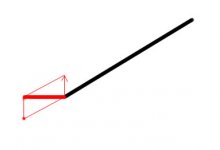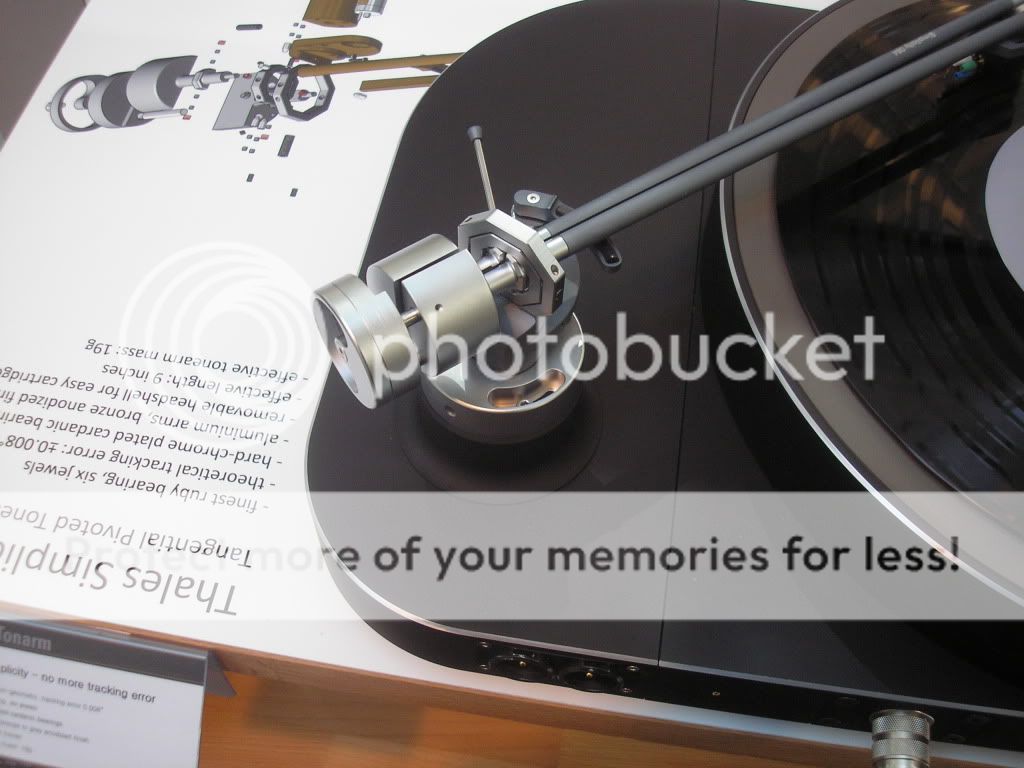Strange posts gentlemen 😕
This thread is the Rodney Dangerfield in this forum, it's got no respect from some people.

Others have great respect for horse coaches .I love audiophiles: They live in a world of dreams and fantasy.
I can't copy the diagram in question so you'll have to refer to the above post.
With due respect to Horii-san, the diagram in section 2 and the explanation of it are pure bunk.
The stylus friction reaction force occurs because of relative motion between the disc surface and the stylus and it therefore must be in the plane of the record and at a tangent to the groove. The relative magnitudes of the stylus friction reaction force and the downn force are determined by the coefficient of friction between the record and the stylus, not by the geometry of the tonearm.
Since the magnitude of the forces shown in the diagram is completely wrong, the rest of the diagram is useless.
Admiting the stylus dragging force appears in the plane of the record and tangent to the groove, the force that appears just by friction is up and not down as suggested by our japanese designer.

You are absolutly right. May-be what means the Japanese designer is that this force (up) applied on the cantilver at the diamond point tend to reduce its angle with horizontal. Same effect than a *down* force applied on the head itself, right ?Admiting the stylus dragging force appears in the plane of the record and tangent to the groove, the force that appears just by friction is up and not down as suggested by our japanese designer.
Fore once, physical laws are on our side: big modulations increase the friction forces, thus, the pressure on the diamond, increasing slightly the tracking ability ;-)
Attachments
Last edited:
guys, I'm thinking (look out I'm dangerouse)
First some assumptions
the RSLabs tonearm:
a typical tonearm:
If one considers the forces acting on the stylus tip, then one must look at any possible change in the angle between the pivot point and stylus tip. In the case of the RS Labs tonearm, this results in a change of (approx) .4982°, but a change of only 3.02%. Interestingly for a coventional arm (as per specs stated in assumptions) the change in the angle is essentially the same (which it should be), but as a percentage it jumps to 8.03%
What does it all mean? Any possible speed change due to a warp actually increases more for a "conventional" arm than The RS Labs arm, assuming the compliance of the cartridge deals with these effectively without affecting the speed. It almost seems counter intuitive. For a specific mounting distance the RS labs has a greater vertical offset, and thus lower errors in both the vertical and horizontal directions.
I may be completely wrong here, but I started from first principles and it seemed logical at the time. 🙂
First some assumptions
the RSLabs tonearm:
- that the pivot point is 68mm above the '0' record height
- that a warp is 2mm
- that the effective length of the arm stays fixed at 239.5mm , but the mounting distance horizontally stays fixed at 230mm
- that it has a vertical O/S of approximately 16.47° when in the static position
a typical tonearm:
- the pivot point is approximately 25mm above the static position
- that any warp is 2mm
- the effective arm length stays fixed at approximately 230mm
- the vertical O/S of the tonearm is approximately 6.203° when in the static position
If one considers the forces acting on the stylus tip, then one must look at any possible change in the angle between the pivot point and stylus tip. In the case of the RS Labs tonearm, this results in a change of (approx) .4982°, but a change of only 3.02%. Interestingly for a coventional arm (as per specs stated in assumptions) the change in the angle is essentially the same (which it should be), but as a percentage it jumps to 8.03%
What does it all mean? Any possible speed change due to a warp actually increases more for a "conventional" arm than The RS Labs arm, assuming the compliance of the cartridge deals with these effectively without affecting the speed. It almost seems counter intuitive. For a specific mounting distance the RS labs has a greater vertical offset, and thus lower errors in both the vertical and horizontal directions.
I may be completely wrong here, but I started from first principles and it seemed logical at the time. 🙂
I may be completely wrong here, but I started from first principles and it seemed logical at the time. 🙂
Yes, you are completely wrong.
The relevant analysis is the change in effective length which has already been done.
Doesn't a warp mean a speed error is occurring, since the groove is elongated in order to get over the hump so to speak? Or does time fix everything in its fourth dimension?
How can you not like a tonearm that looks like this? 🙂
Picture from High End Munich 2012 Audio Show. Wonder what happened to Schroder's LT arm...

Picture from High End Munich 2012 Audio Show. Wonder what happened to Schroder's LT arm...

Thanks for the great pictures, dd!
(After that reading about the fourth dimension, I thought this thread was finished!)
Andy
(After that reading about the fourth dimension, I thought this thread was finished!)
Andy
Fourth dimension or not, I still like these two dimensional audio porno pictures. 🙂
This version of the Thales Simplicity is by far my favorite. The gray and silver is so aesthetically satisfying.

Saw a version with gold trim from the editor of a Hong Kong magazine and it was really tacky and made worse the turntable also has gold trim. Yuck!
This version of the Thales Simplicity is by far my favorite. The gray and silver is so aesthetically satisfying.

An externally hosted image should be here but it was not working when we last tested it.
Saw a version with gold trim from the editor of a Hong Kong magazine and it was really tacky and made worse the turntable also has gold trim. Yuck!
Saw a version with gold trim from the editor of a Hong Kong magazine and it was really tacky and made worse the turntable also has gold trim.

Don't worry, I was there and so was the arm 🙂
Scroll down and you'll find a pic(more elsewhere on the web...)
High End 2012 – die Highlights | Holger Barske
Cheers,
Frank
Scroll down and you'll find a pic(more elsewhere on the web...)
High End 2012 – die Highlights | Holger Barske
Cheers,
Frank
Thanks, Frank! Whew, I was worry you disappeared! 🙂
If you don't mind that I keep up the tradition of loading this thread with more audio porn. Here we go:

This time the arm has an armlift.

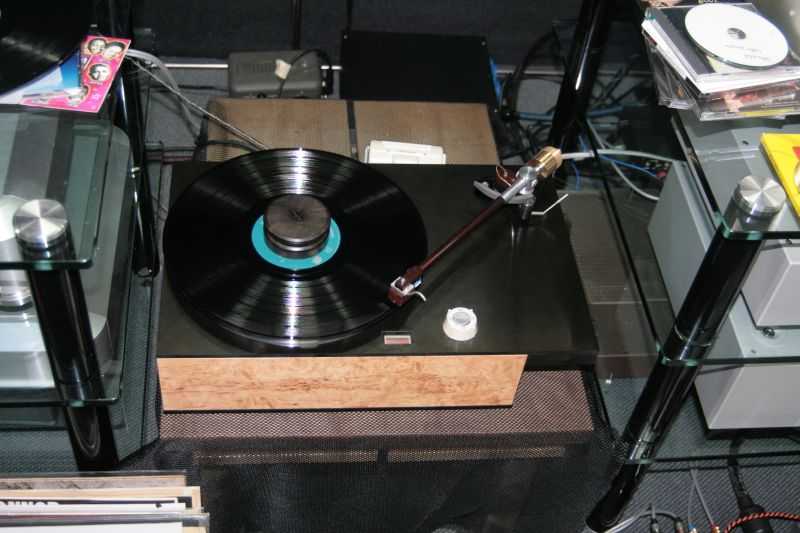
If you don't mind that I keep up the tradition of loading this thread with more audio porn. Here we go:

This time the arm has an armlift.


Our friends at Lenco Heaven forum are discussing similar topics about this genre of tonearms, including posts by Frank. So don't miss the chance to check out analysis and discussion over there. One member is partnering with someone named "Conrad" and I have to assume he's the same fellow member, Conrad Hoffman, from this forum and I look forward to seeing their project coming to fruition! Hooray to tangency! 🙂
Lenco Heaven Forum Tangential Tracking moving pivot tonearm « on: May 08, 2012, 03:36:49 PM »
low pitch: "Sometime back I worked out a locus to keep the stylus in tangent by moving the pivot towards the spindle on a short slide (surprised to find it only required 0.9” travel for a 12” arm). The travel is non linear, but if you mount the pivot on a short arm the non linearity can be offset by the sine. My idea was to have a constant speed of travel, or use a stepper controller (in which case the non-linearity doesn’t much matter). I recently found a collaborator to prototype it with a very sophisticated sensor / control. worked out the general equation just today (OK for linear track – monster for the RT)."
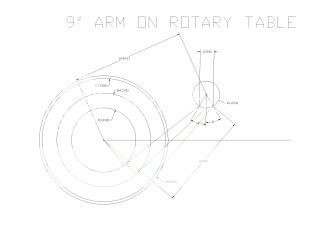
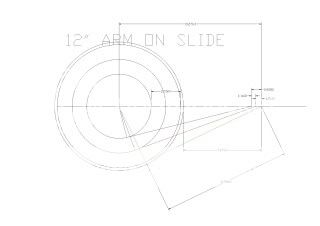
Last edited:
More Schroeder LT tonearm picture.
I wonder if this arm is longer than the one from previous year. Looks like a 12" arm. It appears the mounting distance from the record spindle is farther away.
Is it, Frank?
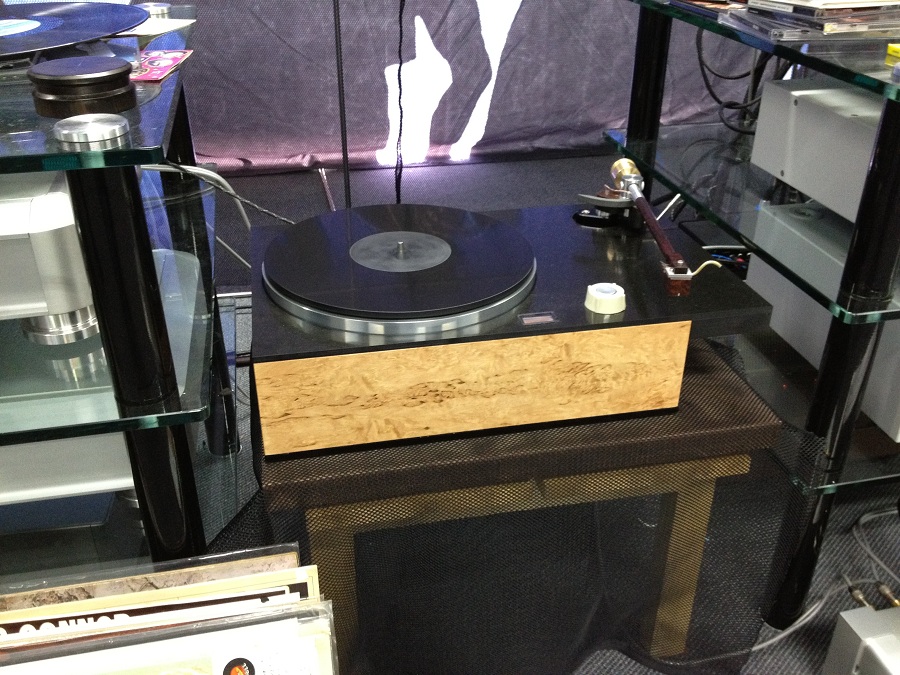
I wonder if this arm is longer than the one from previous year. Looks like a 12" arm. It appears the mounting distance from the record spindle is farther away.
Is it, Frank?

Last edited:
Nope, same length. It's just a VERY small turntable ;-) Doesn't even have a full size platter(I'm not kidding).
Cheers,
Frank
Cheers,
Frank
Transcriptor Transcriber
Here's a curiosity item that I learned about from our friends at LencoHeaven. It's a sliding turntable with stationary tonearm for tangential tracking. I would imagine it uses servo to keep track of tangency.
http://i18.photobucket.com/albums/b133/gib48189/Transcriber/160-c_2.jpg
---------------------------------------------------------------
More pictures at hifi-studio.de.
.
Here's a curiosity item that I learned about from our friends at LencoHeaven. It's a sliding turntable with stationary tonearm for tangential tracking. I would imagine it uses servo to keep track of tangency.
An externally hosted image should be here but it was not working when we last tested it.
An externally hosted image should be here but it was not working when we last tested it.
An externally hosted image should be here but it was not working when we last tested it.
http://i18.photobucket.com/albums/b133/gib48189/Transcriber/160-c_2.jpg
---------------------------------------------------------------
More pictures at hifi-studio.de.
An externally hosted image should be here but it was not working when we last tested it.
An externally hosted image should be here but it was not working when we last tested it.
An externally hosted image should be here but it was not working when we last tested it.
An externally hosted image should be here but it was not working when we last tested it.
An externally hosted image should be here but it was not working when we last tested it.
An externally hosted image should be here but it was not working when we last tested it.
.
I'm - uh - um - - speechless, just speechless.
I would also like to keep my arm that's holding the fork stationary and let the steak fly into my mouth. 😀
- Home
- Source & Line
- Analogue Source
- Angling for 90° - tangential pivot tonearms
